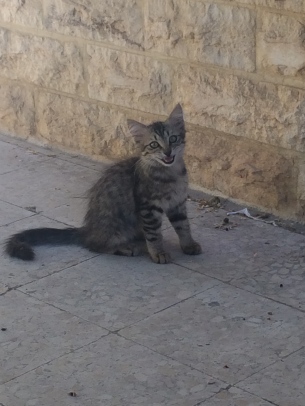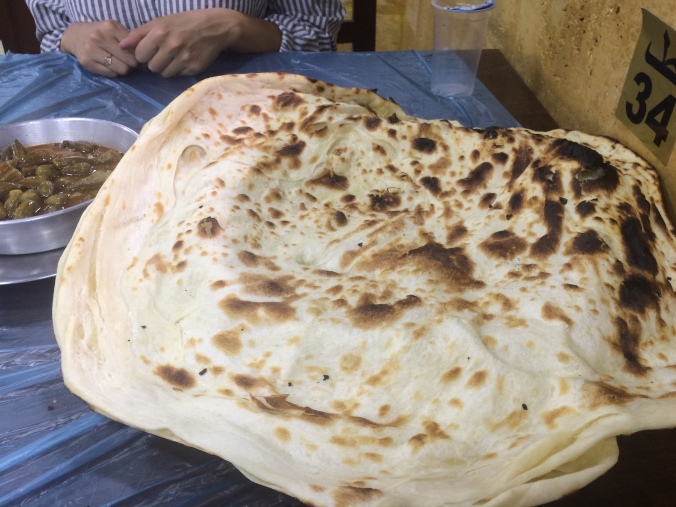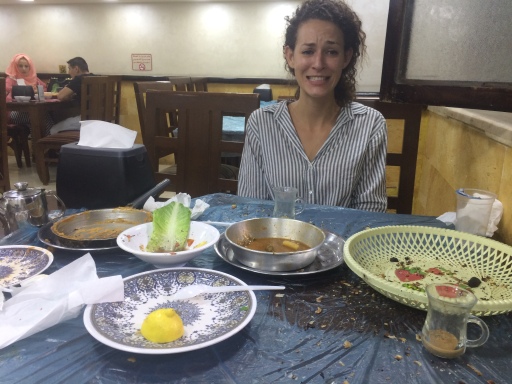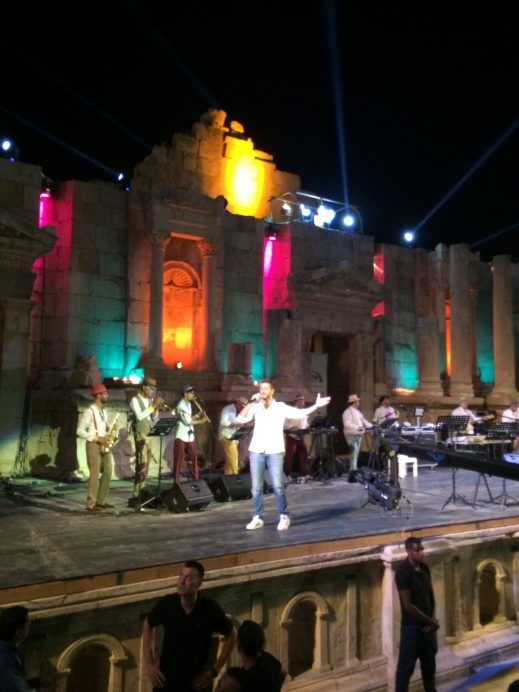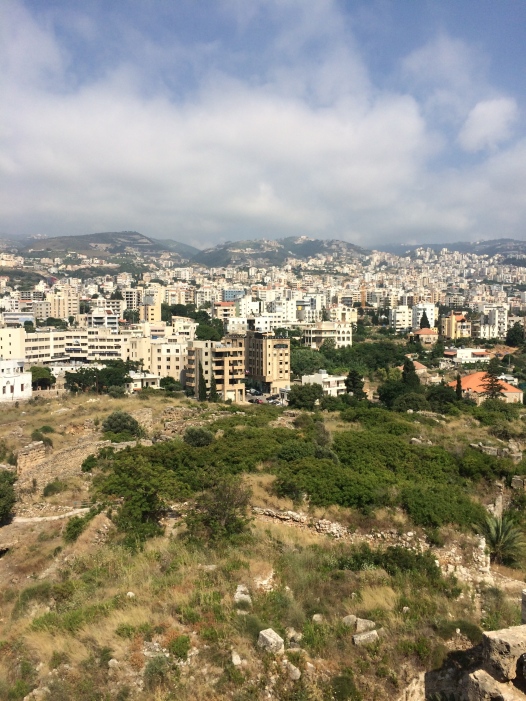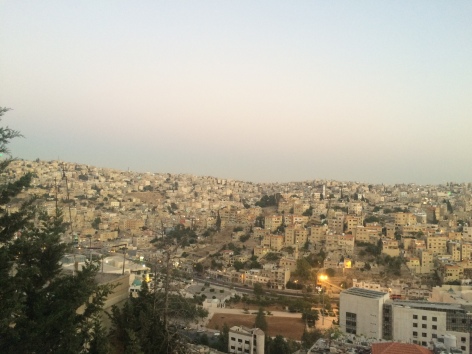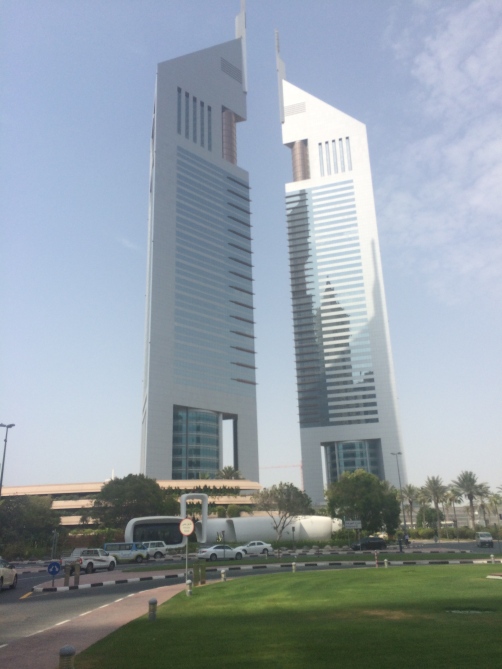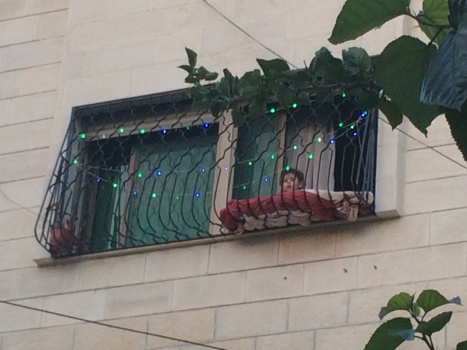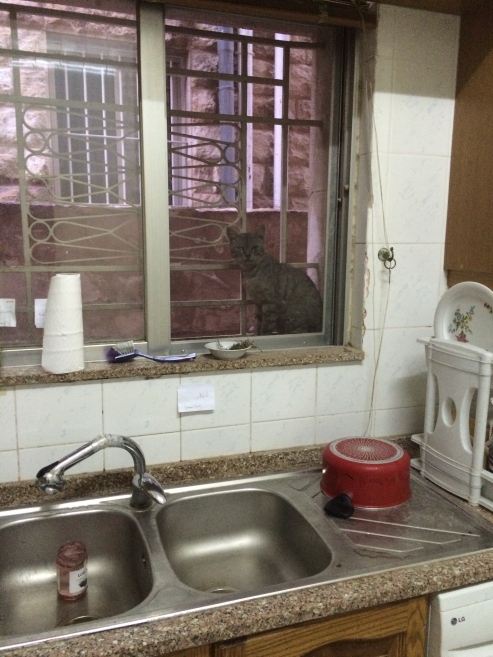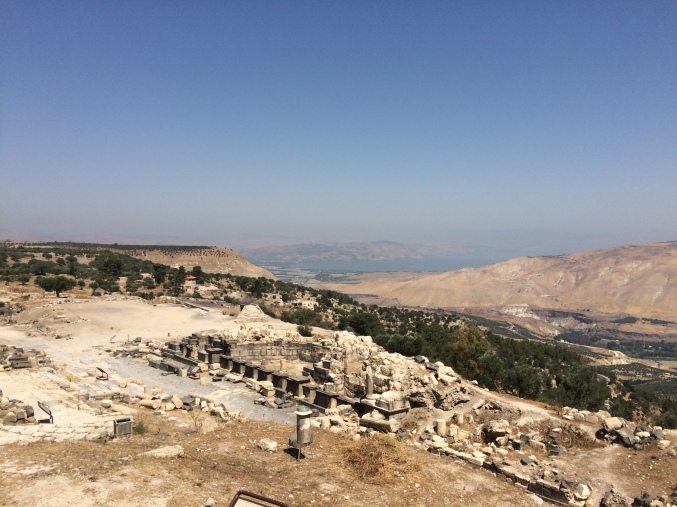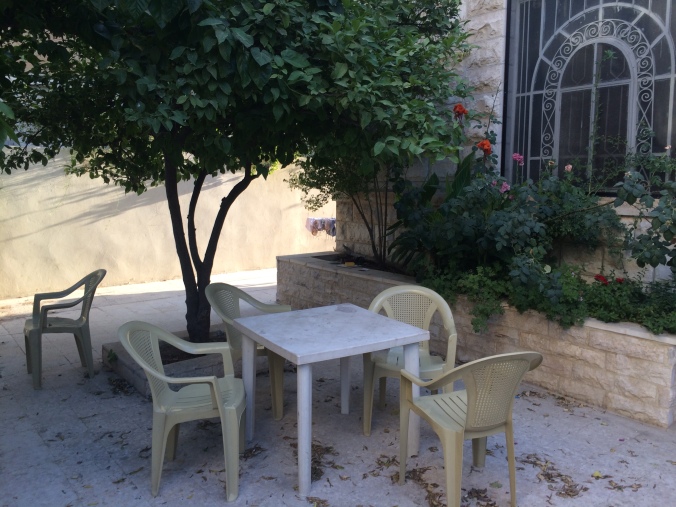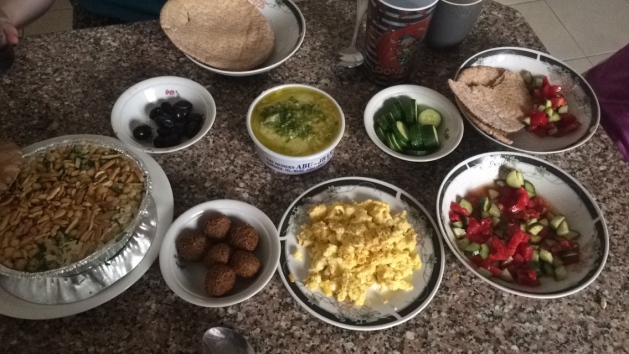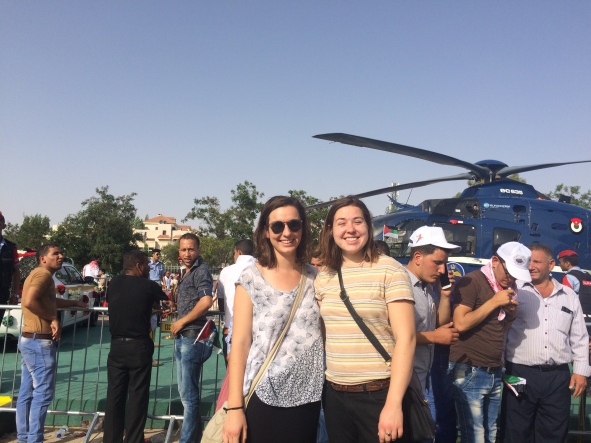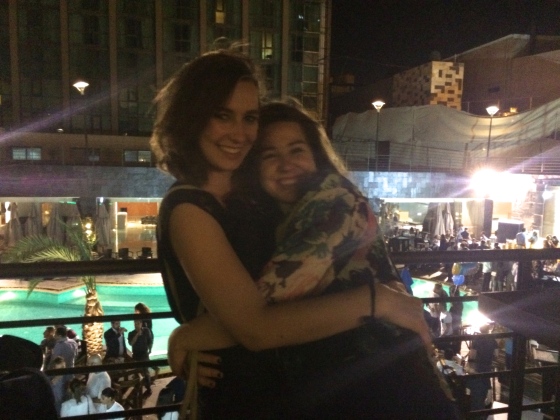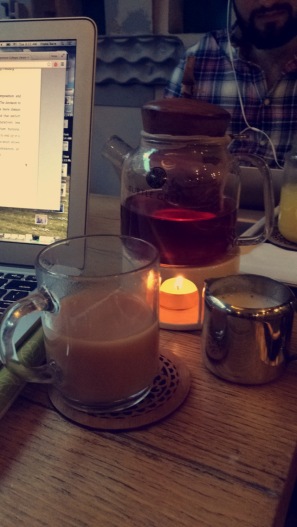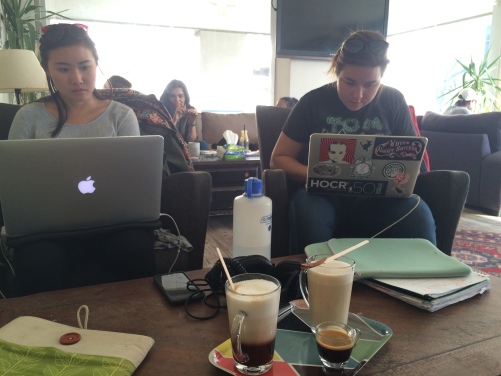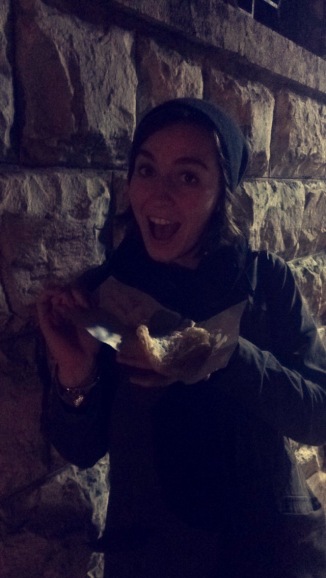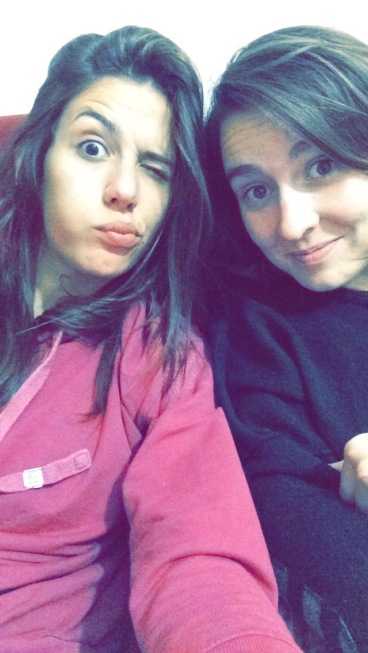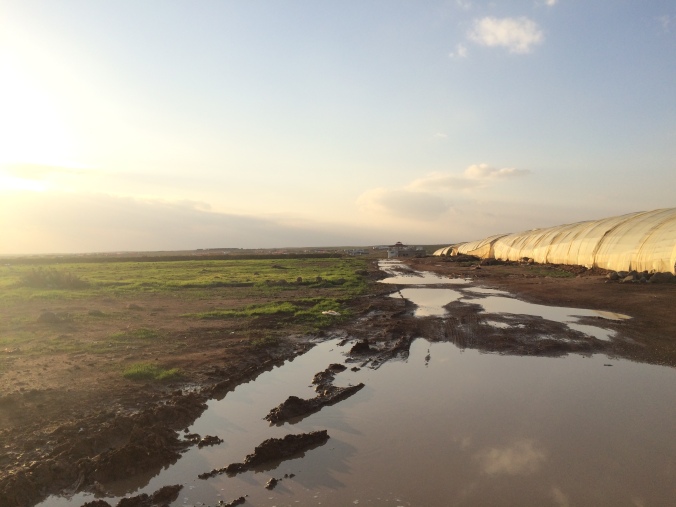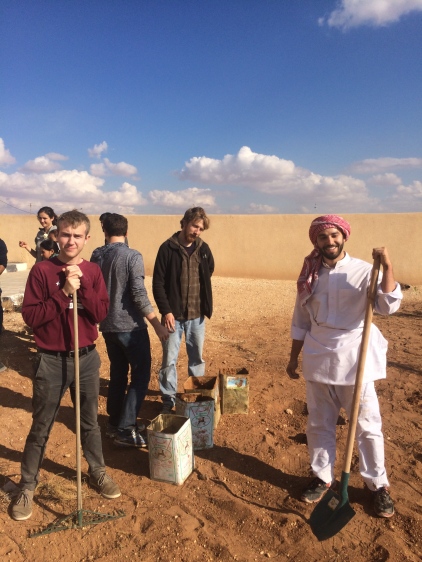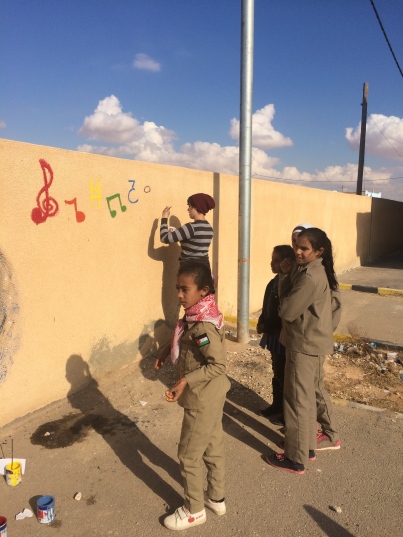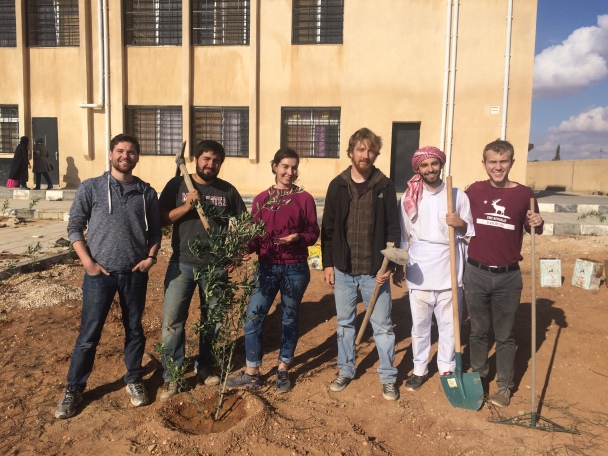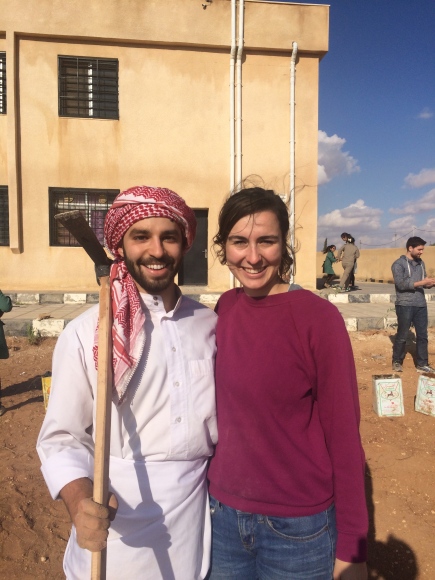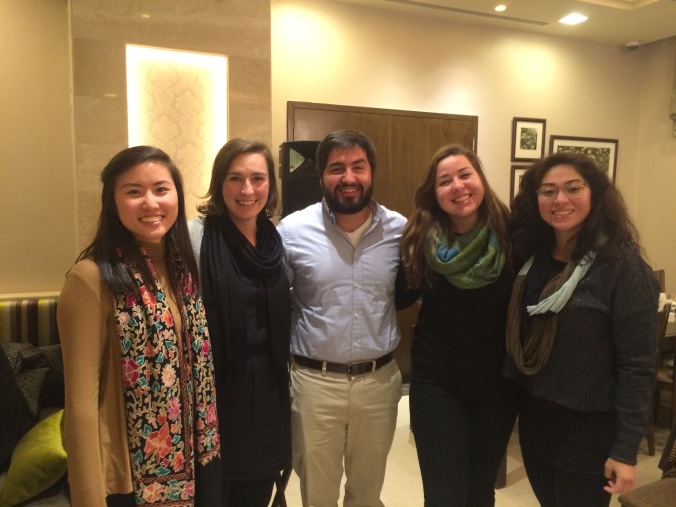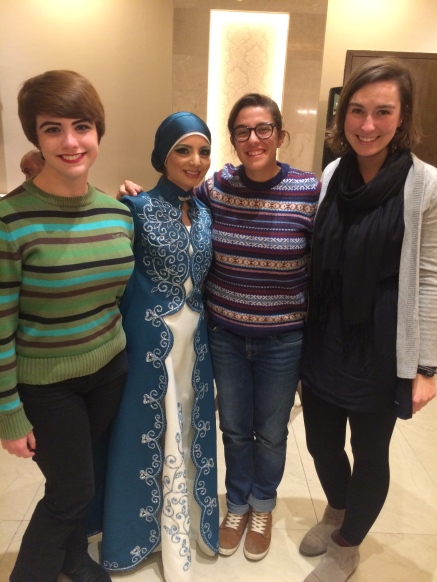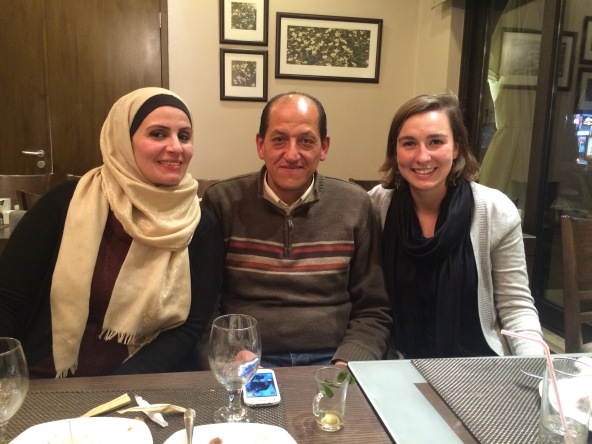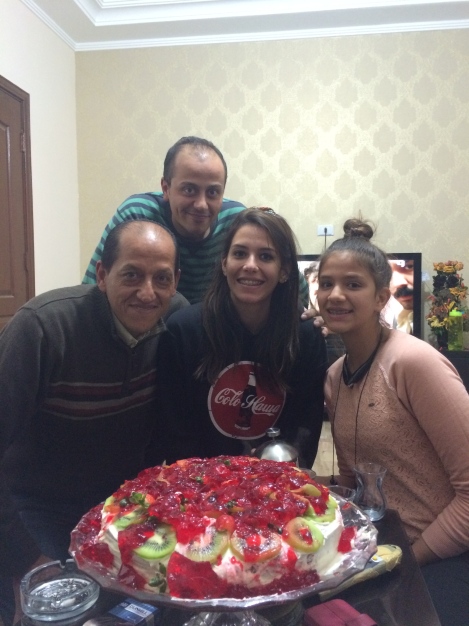My summer abroad came to a close with a visit from my mom who flew halfway across the world, enduring the same 14 hr layover in Frankfurt and who knows how many crying babies on the plane, to explore with me! She started bugging me to write this blog post on her second day in Jordan, but I’m just now getting around to it… Heads up – this is a long one and another will follow about Morocco… If anything, just scan for the photos! 🙂
My mom arrived to Jordan at 2am on the same flight path that I took at the beginning of the summer. Notably, she arrived on a plane with a Jordanian youth soccer team that had evidently just won some major tournament – they walked into the arrivals hall to a full party with confetti, live traditional music, and plenty of people. It was an exciting start to the trip.
Traveling around Jordan with my mom was an interesting experience because I was seeing everything for the first time through her – I think I spent more time watching my mom for reactions rather than actually watching what was around us. I was delighted to see that she was excited and interested in everything, not put off by some of the less glamorous parts of Jordan, definitely proving herself as a hearty and worthy travel companion. I probably got my wanderlust and love of travel from her anyways, so it’s not too surprising.
The first morning, we went out to brunch at Shams El Balad – an awesome organic cafe featuring traditional Jordanian food. My mom loved it and we even made a friend at the table next to us (only the first of many new friends during our two weeks traveling together). We then found our way to the Citadel after some intense taxi negotiations that definitely impressed my mom. The Citadel is on the highest hill in the city, Jabal al Qal’a, and features ancient Roman ruins, a Byzantine church, and a magnificent Ummayid mosque. There is evidence of occupation starting in the Neolithic period, but most of the ruins are either Roman, Byzantine, or Ummayid. After the Citadel, we wandered down to the Roman Amphitheater and then made our way through Wast al-Balad, the busy downtown area. That night, we ate at the classic Hashem’s where we gorged on delicious falafel, baba ghanouj, hummus, and of course – sweet tea. It was a good first day before waking up early the next morning to leave for Petra.
We took the JETT bus, a tourist bus service that offers relatively reliable service and reasonable prices to travel the length of Jordan. We headed straight for Petra, where after a few comical stops along the way (my mom enjoyed checking out the hilariously huge tourist centers along the way featuring dusty overpriced souvenirs and Turkish coffee or tea to fuel the drive). When we stepped out of the bus, it was already a hot day meaning that our sunglasses and hats were critical. Not to mention my backpack heavy with water and salty snacks to keep us going.
Luckily, the majesty of Petra is worth traipsing around under the hot sun all day… Plus, the first time I visited Petra, it was rainy and cold before we got evacuated for a flash flood…so I could manage the heat if it meant I would get to see more of the park. The walk through the Siq is beautiful itself, I had forgotten how the red of the rocks illuminate green trees clinging on for dear life on the side of the little canyon as you make your way towards the Treasury. We were greeted by the typical cacophony of sound at the Treasury – tourists taking selfies, young men offering camel rides, donkeys braying, and the clip-clop of horse carriages coming down the Siq to join the fray. Despite the initial flurry of people, the park was relatively quiet. Tourism has fallen dramatically since 2011 and the start of the Arab Spring, adding to the desperation of young Bedouin men trying to sell cheap souvenirs and donkey rides. However, Petra is still a wonder to behold and I loved watching my mom wide-eyed at it all.
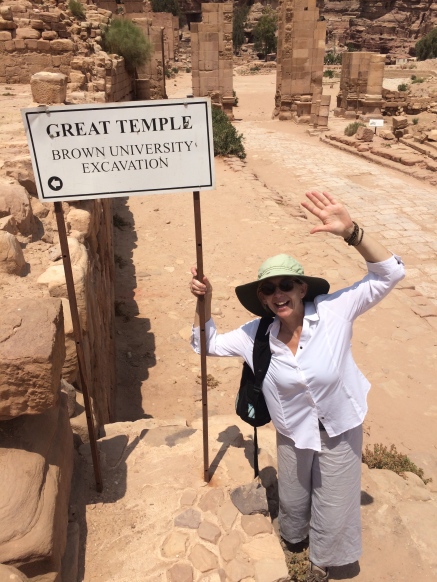
excitement about a Brown excavation site – showing pride for my lil sister’s school
We hiked up to the Monastery, one of the most beautiful sites in the park. I had wanted to see the Monastery on my first visit to Petra, but the heavy rain made climbing the hundreds of rough steps carved into the rock nearly impossible so we had to pass it up. So I told my mom that the climb might be tough, but that we had to go. The Monastery has a massive facade, so large that it is hard to take it in when standing in front of the face. It’s misnamed – the monument was likely a temple to the Nabatean king Obadas I from the first century. Some clever entrepreneurs have set up a tea shop in a cave across from the Monastery, a perfect place to buy cold water and munch on some of our snacks. We passed a decent chunk of time here, just taking in the whole scene – marveling at the Monastery while also observing the range of tourists there with us. We also climbed up to a higher point a little bit past the Monastery to be rewarded with incredible views over the Petra basin and Wadi Araba.
We spent a long day at Petra and while I definitely can’t say that we saw it all, we saw a lot – from the Treasury to the Monastery to the amphitheater to the Temple of the Winged Lion. The park is huge and I feel like there is always more to see. I could definitely picture returning for third and fourth times, especially to do some multi-day trekking to Little Petra and Dana, other wonders of Jordan. I think one of the coolest parts of Petra is the incredible natural beauty, along with the inspiring ancient ruins that demonstrate the power of humankind to build. After taking it all in, with very sore feet, we kicked back and enjoyed some beers to end the day.
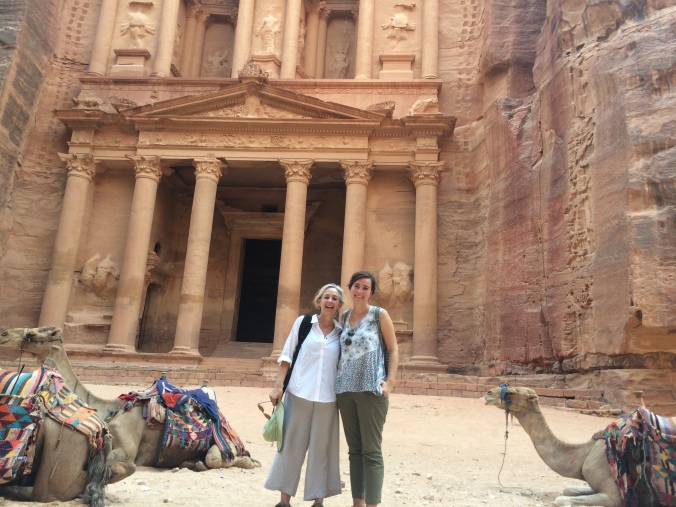
in front of the Treasury 🙂
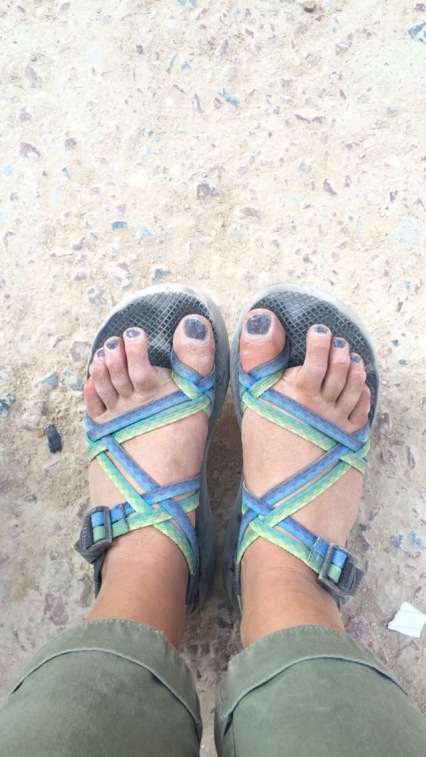
dirty desert Petra feet
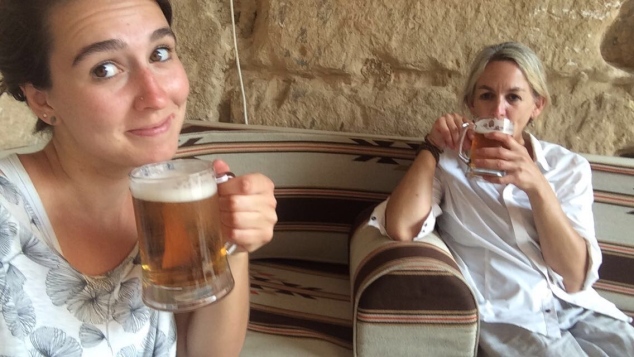
post-Petra beers
In the town of Wadi Musa outside of Petra we stayed at a cute bed and breakfast where we were hosted by a kind Belgian lady. Notably, she also has two horses, a donkey, and a cat. So we made some more new friends… My mom wants to become a donkey keeper at some point in the future so she was practicing her donkey-whispering skills with all the donkeys we came across. The roof of the b&b also offered gorgeous views over Wadi Musa that we enjoyed while drinking coffee. It was a great end to our time in Petra and gave us the necessary fuel for our day in Wadi Rum.
It takes about an hour and a half to get to Wadi Rum from Petra, but we took the King’s Highway which offers incredible views over the valley. Our taxi driver was also kind to make a stop to allow my mom to marvel at camels on the side of the road…
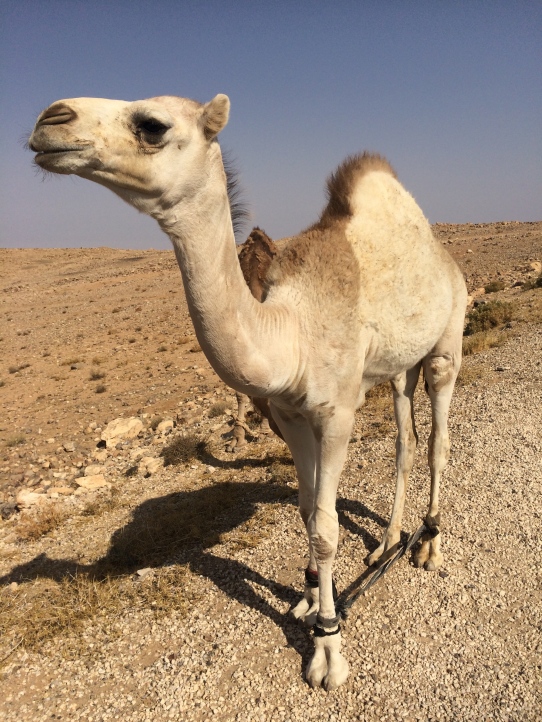
We arranged for a day-long tour of Wadi Rum, plus a camel ride, with a nice guy named Mehdi. We were joined by a solo traveler, an older Spanish guy who was touring Jordan for a couple weeks. He is an incredible photographer and had some interesting stories from past travels so he was a good companion. We had a Bedouin guide named Oudi who was shy at first, but quickly warmed up to our jokes and antics. The first thing of the day was an hour long camel ride out of Wadi Rum village into the vast desert. My mom put a camel ride as one of the top things on her list, as after riding various other creatures it seems like a camel should not be missed. I tried to tell her that it wasn’t a particularly comfortable experience, but I could not dissuade her and so on a camel ride we went!
In the end, it was pretty enjoyable and ended at a little camel watering spot where all the guides congregated for tea and stories before taking people out on tours. Here we got to drink some Bedouin tea, very sweet as always, though the guides did let me in on the secret that they have separate tea for Bedouins and for tourists. The tourist version is less sweet, but they poured me some of their tea – I think my Arabic skills impressed them and it was fun to joke around with them. This experience was very different from my first visit to Wadi Rum – it was summer so very hot, but also being in a small tour group rather than with a large study abroad program meant we could see more and I could talk to more people. For example, my mom convinced our guide Oudi to let her drive the truck across the desert. It took her a few minutes to get her manual abilities up to speed and it was a little more bumpy with her behind the wheel, but she did a great job. I also think the other Bedouin guides were pretty impressed!
After a few hours of driving around, climbing up and down sand dunes, we stopped at a tent for tea with two Bedouin guys – Sami and Abdullah. We stopped for tea and to get out of the sun, but they were just starting to make some lunch so we decided to eat with them. We chopped up tomatoes and onions to make galayah and cut more tomatoes and cucumbers for salad. I tried to be useful, but Sami teased me because I was not as efficient at chopping cucumbers as he was – thankfully, he did say that I should be able to find a husband after I improve my salad-making skills a little bit. The guys were very nice, hardly older than me, and with impressive English skills so we had some nice conversation. There were two young cats hanging around and Sami showed me pictures on his phone of his other kittens at home and his family. We broke bread together, digging into delicious tomato stew, salad, hummus, and eggs. To end the meal, we had tea and some interesting political conversation about the current state of the Middle East. Although I did not hear anything new, I was glad to have my mom hear perspectives about Iraq and Syria from a Jordanian firsthand, as it is more valuable than me just relaying past conversations. Sami then showed off his henna skills, decorating both me and my mom with beautiful curling flowers. Everybody then pulled mattresses to cool spots near the rocks to take post-lunch naps and beat the heat. It was a perfect stop with food, good perspective sharing, and cats!
My mom loved Wadi Rum and I was glad – it’s definitely one of my favorite places. Massive red rocks tower above sandy expanses and dunes, while camels plod in the distance. It truly feels like another world – no surprises that it’s been the site of many films and fantasies. We saw crazy rock formations called ‘the mushroom’ and ‘the chicken,’ climbed across crazy rock bridges, and jumped from dunes. Wadi Rum has so much to offer for anyone who likes the outdoors, it truly is a natural playground.
The long day flew by, as it was filled to the brim with beautiful moments and laughter. After watching the sunset from the top of a warm, red sand dune, we headed to our campsite for the night. The site was tucked in a cove of rocks, making us feel truly alone out in the desert. We feasted on zarb, traditional Bedouin barbecue that is buried in the ground to cook for several hours, and finished dinner with plenty of sweet tea. Oudi entertained us with riddles, games, and songs until darkness was fully settled and the stars came out. At that point, the sky was so illuminated with twinkling stars that it was hard to focus on anything else. There was a new moon, meaning the stars shone brightly with nothing to distract from their light. We fell asleep under a blanket of stars, having dragged our mattresses out into the cool of the open air.
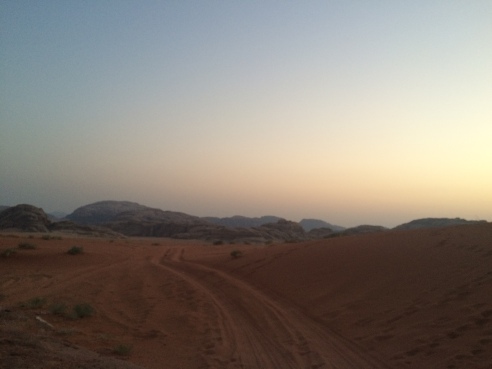
My mom and I were both sad to leave Wadi Rum the next morning. It was hard to drive away from all that calm and beauty.
The next day we headed to the Dead Sea for some serious relaxation. It was very hot, making the shade of pool umbrella valuable, but few things beat just relaxing by the pool on a beautiful day and reading a book. I was also excited for my mom to experience, the Dead Sea because it is something extremely unique. On the way there, we also passed many military and police checkpoints that monitor the road leading south from Amman. People traveling to the Israeli/Palestinian border from Jordan take the same route, leading to the large amount of military stationed along the way. After passing multiple checkpoints, we made it to the familiar winding road down to the Sea. The day was perfect in its drowsy warmth, providing some necessary R&R after two busy days exploring Petra and Wadi Rum. That evening, after returning to Amman, we made ourselves a little dinner and then set out to see the Friday Market and wander the city. It was a wonderful day.
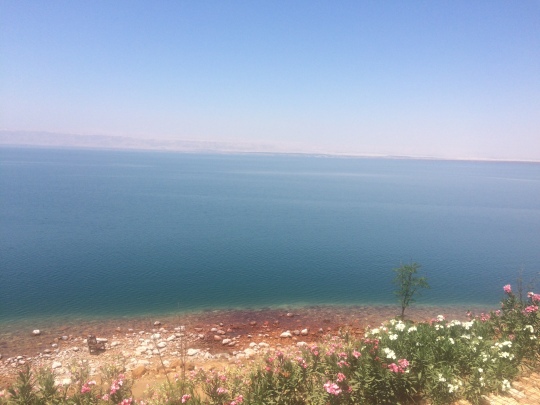
the Sea
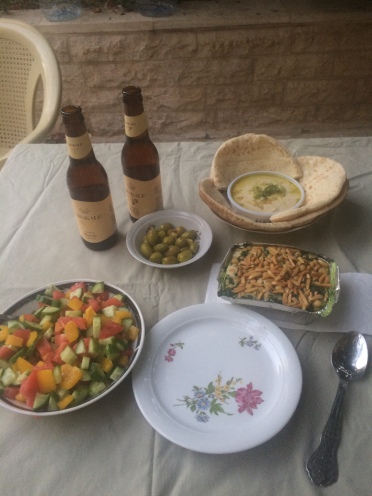
our little dinner
The next day, we got up early to head to Jerash – a city about 50km north of Amman. We planned to go by public bus, but after waiting for about 30 min, we were approached by a guy who was sick of waiting for the bus to fill (the only schedule for buses) and offered to split a taxi. We took him up on the offer, willing to pay a few extra JD to get to the city earlier. Jerash is a fertile area of Jordan and the city is surrounded by rolling hills and farms. It is the site of the Greco-Roman ruins of Gerasa, an ancient city that was likely founded by Alexander the Great. It is considered one of the best preserved ancient Roman cities in the region, boasting incredible columns, Hadrian’s Arch, two temples, the Oval Forum, two theaters, and a large Nymphaeum (fountain). The ruins are definitely worth the short trip from Amman and despite the 100+ temperature, we had a great time wandering the ancient city.
That afternoon, after returning to Amman, we had a peaceful afternoon wandering the hills of Jabal Amman and doing a bit of last minute shopping (had to get the lil sis something nice). It was our last full day in Jordan – the next would just include cleaning the apartment, meeting with my landlord, and heading to the airport. In order to celebrate a great first week of travel together, we treated ourselves to a beautiful dinner in an old villa, delighting over traditional Jordanian dishes. That evening I definitely felt a little emotional hearing my last Jordanian call to prayer of the summer. We stopped to watch birds flutter in the evening sky while the prayer rose slowly over the city and I felt a sense of real happiness, so glad that I decided to spend the summer in such an incredible county.
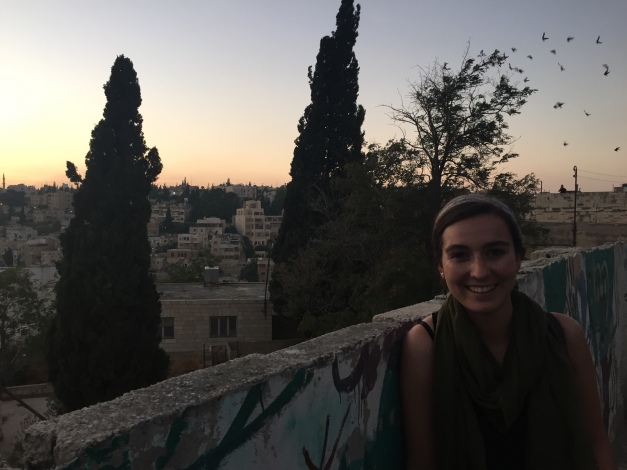
More pictures may follow from Jordan…also a post about our week in Morocco with many more photos!















































































